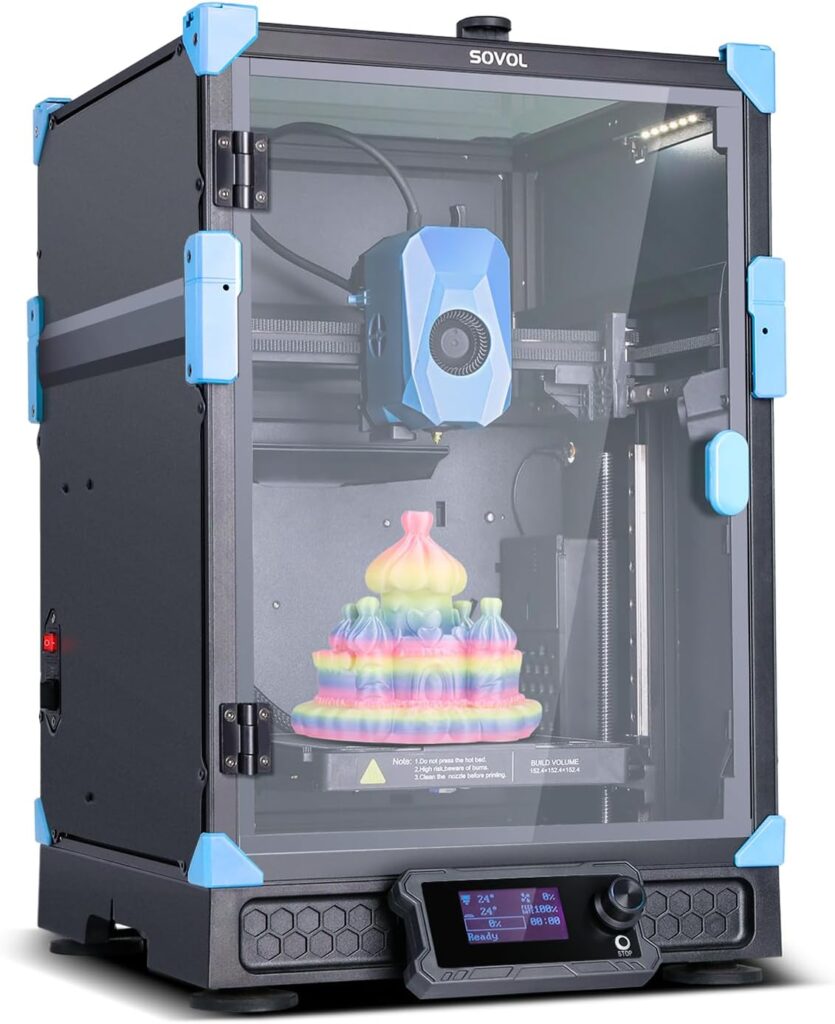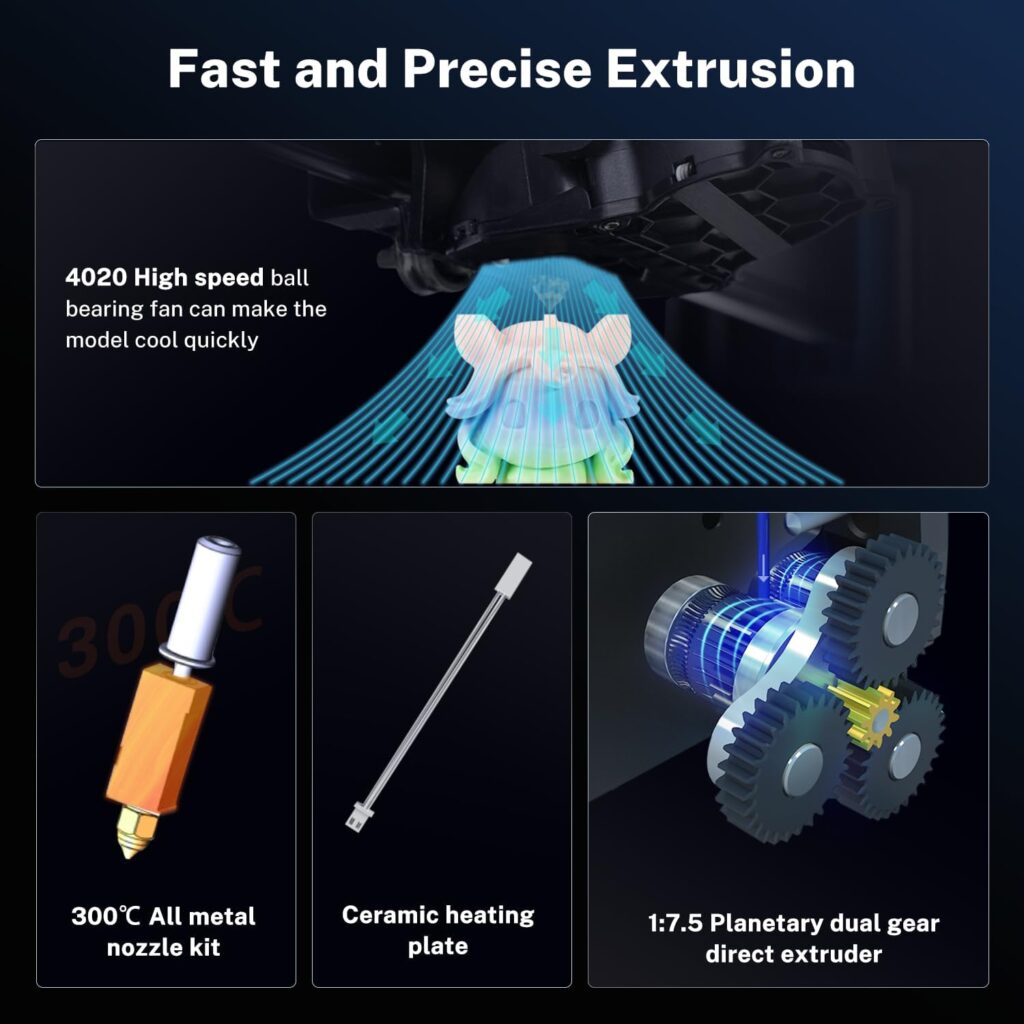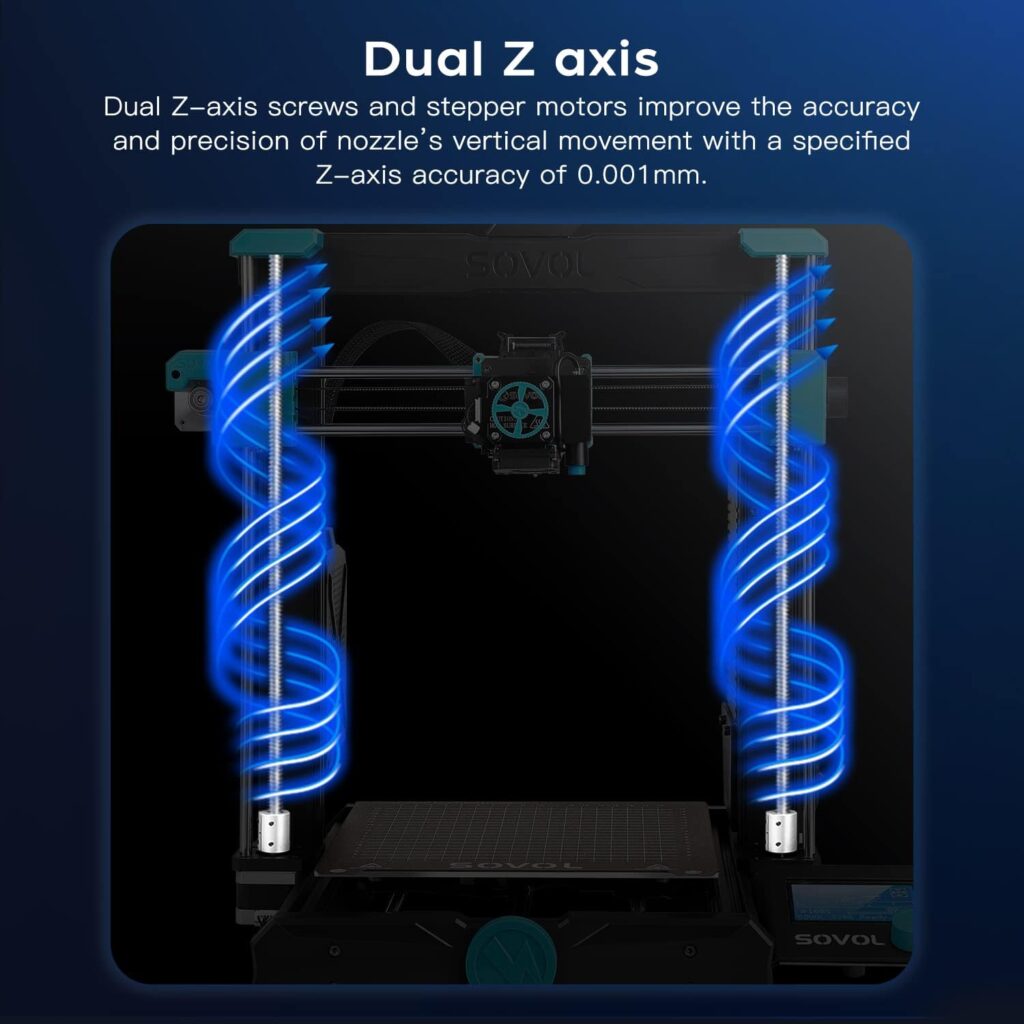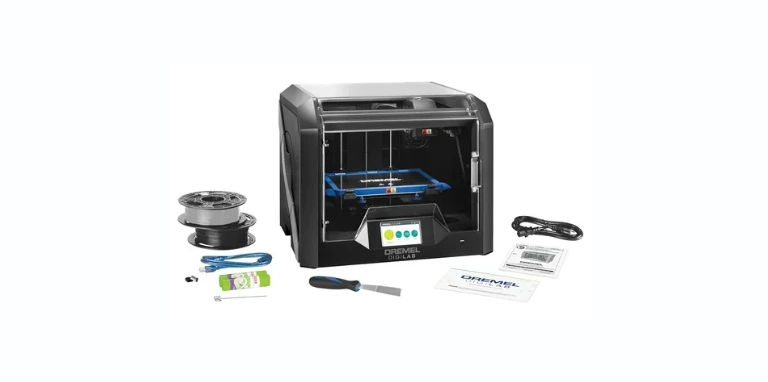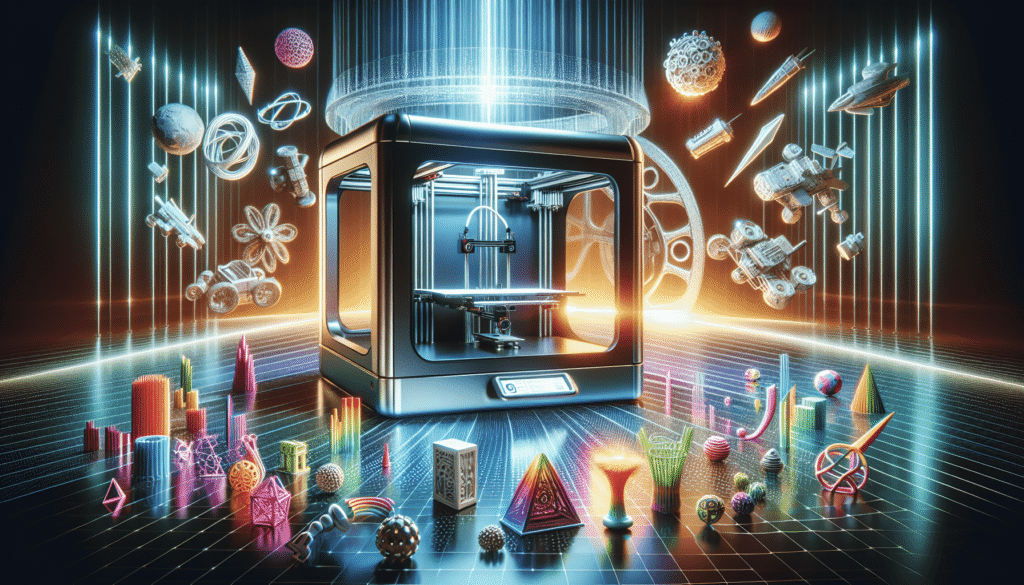What happens when a 3D printer makes my coffee cool down slower than it finishes a print?
Why I Picked the Sovol Zero 3D Printer for My Desk
I wanted speed without the stress-induced gremlin noises a lot of machines make when you push them. The Sovol Zero 3D Printer, 1200mm/s High Speed CoreXY 3D Printers with Eddy Scanning & Pressure Sensing, 350℃ Nozzle & 120℃ Heated Bed Heating, XYZ Full Linear Rails Open Source Build Volume 6X6X6in sounded like the sort of device that would either transform my life or my outlets. It promised unmatched velocity, real auto-leveling, and open-source freedom. It also promised to keep my indoor air less terrifying, which, as a person who has smelled too many questionable plastic fumes, I appreciate.
I’ve spent too many nights coaxing printers to behave with the patience of a camp counselor during a thunderstorm. I wanted something fast and grown-up—with the manners to match. The Sovol Zero sold me on that premise, and I decided to see if it could keep up with my messy curiosity and my optimism that borders on denial.
Sovol Zero 3D Printer, 1200mm/s High Speed CoreXY 3D Printers with Eddy Scanning & Pressure Sensing, 350℃ Nozzle & 120℃ Heated Bed Heating, XYZ Full Linear Rails Open Source Build Volume 6X6X6in
What the Sovol Zero Actually Is (And Why That Matters to Me)
I’m not looking for a shrine to precision that takes a long weekend to produce a keychain. I’m looking for dependable speed with print quality that doesn’t look like it has seen things. The Sovol Zero is built around a CoreXY motion system—essentially a smarter, lighter way to move the print head fast without flinging accuracy into the next county. It claims a max speed of 1200 mm/s, which is cartoonishly fast if you’re used to the more pedestrian 100–200 mm/s.
Beyond speed, it offers genuinely modern features:
- Auto-leveling that uses eddy current scanning and pressure sensing
- A 350°C hotend and a 120°C AC heated bed
- Full linear rails on X, Y, and Z
- Built-in camera with Obico support for monitoring and time-lapses
- Air filtration for higher-temp filament emissions
- Open-source firmware and modding potential
- Chamber temperature monitoring for consistency
The build volume is a neat 6 x 6 x 6 inches (about 152 x 152 x 152 mm), which is a sweet spot for most of my projects. I don’t often need to print a life-size human skull, but I do like to render small storage solutions, toy parts, fiddly art, and the occasional gadget prototype.
Setup: How Long It Took Me to Go From Box to Benchy
If you’ve ever assembled a printer that felt like building a harp out of spaghetti, you’ll understand why I value a straightforward setup. The Sovol Zero came together in an evening without adding new words to my vocabulary. The structure felt rigid out of the box, and the linear rails gave it a “grown-up machine” vibe that I usually only see in pricier kits or home-built projects.
The wiring was tidy. The instructions were direct. I didn’t have to pry off mystery zip ties or hunt for that one tiny bag of parts usually labeled “Maybe?” Within an hour and a half, I had the basics sorted, and the interface guided me through the initial calibration. The first auto-leveling routine took less time than it takes me to make tea while ignoring my email.
The Speed Story: CoreXY at 1200 mm/s
Speed isn’t just a number—it’s a promise that can either bring joy or provenance to a pile of spaghetti. The Sovol Zero’s CoreXY setup means the print head moves with a lighter touch than a traditional Cartesian gantry, letting it accelerate fast and change direction without wobble that ruins detail.
I’m cautious with speed claims. Max speed is one thing; usable speed is another. In real life, what mattered to me was how fast I could push it while getting parts I wouldn’t be embarrassed to show a friend. With the Sovol Zero:
- Fast draft prints are genuinely fast. I knocked out functional parts in minutes instead of an hour.
- For detail work, I backed off the extremes, and the quality stayed crisp.
- The linear rails and damping meant less ringing than I expected at high speeds.
I still don’t run it at 1200 mm/s for everything—no one prints heirlooms at warp nine—but it’s there when I want to crank out brackets, test fits, or get through a queue without wasting a day.
Next-Gen Auto-Leveling V3.0: Eddy Scanning + Pressure Sensing
This is the part that made me feel slightly spoiled. Instead of the “tap-tap-tap” probing method, the Sovol Zero uses eddy current scanning—which relies on magnetic induction—to map the bed height without physical contact. Then it uses pressure sensing to find the precise touchpoint. The two-step system makes for a cleaner, more confident first layer.
My first attempt at a high-speed print started without the ritualistic scraping and pleading I’ve known on other machines. The eddy scan built a Z compensation grid quickly, and the pressure sensor refined it. Bed calibration was set-and-forget enough that I didn’t grimace at the thought of switching filaments or re-running the process.
In practice, this meant:
- First layers stuck down with the calm authority of a seasoned librarian.
- No weird corner lift surprises when I changed filament types.
- Less manual tweaking; more actual printing.
High-Temp Hardware: 350°C Nozzle and 120°C AC Heated Bed
The 350°C hotend made me feel like I had a backstage pass to the grown-up filament aisle. PLA and PETG are standard, but I could move comfortably into ABS, ASA, Nylon (PA), PC, and even fiber-reinforced blends like PLA-CF and PETG-CF. When I want to pretend I run a miniature factory, those carbon-fiber mixes are my catnip.
The AC heated bed reaches 120°C quickly, which is essential if you’re printing high-temp materials and don’t want warp to ruin your day. AC beds generally heat faster and hold temperature more evenly across the plate. The Sovol Zero also includes overheating protection, which I consider the electrical equivalent of seatbelts—unexciting until you need it, and then it’s the most thrilling thing in the room.
Build Volume Reality Check: 6 x 6 x 6 Inches
I’ve learned the hard way that bigger isn’t always better. The 6 x 6 x 6 inch capacity is more than enough for most of my projects: cable organizers, small enclosures, tabletop bits, phone stands, fixtures, and decorative pieces that don’t double as a coffee table. If you need a cosplay helmet in one go, you’ll want something bigger. If you like printing frequently and fast, this size hits a sweet spot.
I also like that smaller volumes heat faster, hold temperature better, and show fewer mechanical sins at high speeds.
Chamber Temperature Monitoring: Quiet Hero of Consistency
Any printer that mentions chamber monitoring wins my cautious heart. Temperature swings mess with layer adhesion and warp-prone materials. The Sovol Zero includes a chamber temperature sensor, and there’s an upcoming chamber heater component in the ecosystem. With real-time chamber temp info, I could time my prints better and avoid wild swings on longer jobs.
Even without active heating, simply knowing what’s happening inside the box helps. I learned when to avoid ABS during cold spells and when PETG would behave without argument.
Built-In Camera With Obico Support
I treat the built-in camera like a tiny private investigator for my prints. It does real-time monitoring and detection through Obico (which it supports), and it records time-lapse footage for when I want to pretend I’m running a glamorous print bureau instead of a corner of my office.
It’s not just a toy, either:
- I caught a snag early thanks to a quick mobile check.
- I used time-lapses to see where my settings went off track.
- Remote monitoring spared me from hovering like a concerned parent over a birthday cake.
Air Filtration for High-Temp Filaments
Printing higher-temp materials can smell like your house just enrolled in a chemistry minor. Sovol includes an air filtration system designed to scrub VOCs and particulates during printing, which is kinder to lungs and roommates. It’s not a replacement for room ventilation, but it runs quietly and makes a discernible difference with ABS and ASA.
For me, it turned long ABS prints from “what is that odor?” to “oh, it’s printing.” This is the kind of baseline civility I like in a machine.
XYZ Full Linear Rails and Silicone Damping: Calm at High Speed
If speed is the headline, the linear rails are the body text. All three axes ride on rails, not wheels, which gives a tighter, more controlled motion profile. The silicone damping pads absorb vibrations that would otherwise ripple through parts like a bad memory.
The result in my prints:
- Sharper corners and cleaner text embossing at higher speeds
- Less ghosting on vertical surfaces
- Quieter directional changes that don’t sound like a band saw trying to harmonize
I could push perimeter speeds on functional parts without seeing the wavy artifacts that usually appear when machines get overexcited.
Open Source: My Tinker-Friendly Playground
I’m a chronic fiddler. The open-source approach here makes me comfortable in a way that closed ecosystems never do. I can tune, tweak, and eventually break things creatively. The printer doesn’t lock me into one way of doing work. Being able to choose slicers, adjust firmware behavior, or add mods as the community invents them means this machine can grow with me.
I like to install new profiles, try unusual infill patterns, and change acceleration and jerk settings for specific projects. The Sovol Zero’s open ethos gave me permission to do all that without voiding my dignity.
A Quick Look at the Sovol Zero’s Key Features
Sometimes I need a clean table to keep track of what matters. Here’s how the Sovol Zero’s headline features translate into daily use for me.
| Feature | What It Is | Why It Matters | My Experience |
|---|---|---|---|
| 1200 mm/s CoreXY | Lightweight, fast motion system | Faster prints with better accuracy at speed | Blazing for drafts; still refined for detail when tuned |
| Auto-Leveling V3.0 | Eddy current scan + pressure sensing | Reliable first layers with high precision | I stopped re-leveling constantly; first layers are consistent |
| 350°C Nozzle | High-temp capable hotend | Supports advanced filaments | PLA to PC without drama; CF filaments look crisp |
| 120°C AC Heated Bed | Rapid, even heating with protection | Reduces warp; stable over long jobs | Heats quickly; holds even temps over multi-hour prints |
| Chamber Temp Sensor | Real-time chamber readings | Better consistency for ABS/ASA | Helped plan prints; fewer surprises with warp |
| Built-in Camera + Obico | Onboard monitoring and time-lapse | Remote checks and diagnostics | Caught a failed first layer early and saved time |
| Air Filtration | Filters VOCs and particulates | Cleaner indoor air | Noticeably less odor with ABS |
| Full Linear Rails (XYZ) | Rails on all axes | Smoother motion; better control | Sharper details at speed; less ghosting |
| Silicone Damping | Vibration absorption | Stability under fast moves | More stable high-speed prints |
| Open Source | Customizable firmware and workflow | Freedom to mod and tune | Easy to tailor to my projects |
| 6x6x6 in Build Volume | 152 x 152 x 152 mm space | Sweet spot for daily parts | Practical for most prints I do |
Print Results: What I Actually Got on Real Jobs
Claims are cute; parts are proof. I printed several things to get a feel for how the Sovol Zero behaves across materials.
- PLA: High-speed utility parts came out clean with good bridging. Lettering on the surface stayed legible even with hurried settings. I could reduce layer time without little meltdowns.
- PETG: Stringing was manageable and easily tamed with temperature and retraction tweaks. Walls felt sturdy, and the gloss stayed intact at higher speeds.
- ABS/ASA: With the chamber monitoring and the heated bed hitting 110–120°C, corners stayed down. The filtration kept the room civilized.
- Nylon (PA): The 350°C head made this possible without the printer feeling like it was on a spa day. Parts were tough, and small gears meshed nicely without gritty edges.
- PC: I wouldn’t call it effortless, but it was viable. With the right temps and slowdowns in specific sections, the parts looked confident. The bed heat stability helped a lot.
- Fiber-reinforced blends (PLA-CF, PETG-CF): Surface textures looked fantastic, and dimensional accuracy stayed true for functional assemblies. The rails made a noticeable difference in edge quality at moderate speed.
Here’s a snapshot of my test runs:
| Material | Nozzle Temp | Bed Temp | Print Speed (rough) | Result Notes |
|---|---|---|---|---|
| PLA | 215–225°C | 60°C | 300–500 mm/s draft; 150–250 mm/s for quality | Excellent detail at moderate speeds; fast drafts still tidy |
| PETG | 235–245°C | 80°C | 200–350 mm/s | Slight stringing at top speeds; great strength |
| ABS | 245–255°C | 100–110°C | 150–250 mm/s | Minimal warp with chamber temp awareness |
| ASA | 250–260°C | 100–110°C | 150–250 mm/s | Good UV-stable parts, edges stayed down |
| PA (Nylon) | 255–275°C | 70–90°C | 120–220 mm/s | Strong parts; keep humidity low |
| PC | 270–300°C | 100–110°C | 120–200 mm/s | Demanding but doable; enclosure heat matters |
| PLA-CF | 220–235°C | 60°C | 180–300 mm/s | Gorgeous matte finish; stiff results |
| PETG-CF | 245–255°C | 80–90°C | 150–250 mm/s | Tough, clean surfaces with minimal warp |
Note: I tuned my speeds a lot. I rarely used 1200 mm/s for anything but stress tests or pure drafts. The printer can sprint; I liked it best at a fast jog with occasional heroic bursts.
The First Layer That Didn’t Make Me Flinch
I’ve been betrayed by first layers before. You think everything’s fine and then the nozzle carries a noodle across the bed like a toddler with spaghetti. With the Sovol Zero, the Auto-Leveling V3.0 did its job without the assumptions. The eddy scan mapped the surface; the pressure touchpoints sharpened the map.
I used a light glue stick for ABS and ASA, nothing for PLA and PETG. I also noticed the AC bed stayed consistently flat and hot across the plate, which matters more than we pretend. Warped beds are where hope goes to nap.
The Controls and Software Side of Living With It
I’m not married to a single slicer. The open-source nature lets me pick my tools. Profiles were easy to set up, and I didn’t have to fight proprietary lock-ins. Firmware behavior felt transparent, and the machine never hid the important knobs behind patronizing menus.
The interface led me through calibration, filament changes, and bed tramming checks with solid prompts. I liked seeing the temperature readings in real time, including the chamber sensor. The camera feed on Obico helped me walk to another room without feeling like I’d abandoned a toddler with crayons.
Noise, Smell, and Keeping the Peace at Home
Speed often equals noise. Here, the linear rails and damping made a difference. It’s not silent, but it’s the kind of sound that blends into a home office rather than announces itself in the neighbor’s yard. Rapid direction changes didn’t scream. The fans sounded normal, not like an airplane deciding whether or not to commit to takeoff.
The built-in filtration noticeably reduced rancid plastic notes with ABS and ASA. I still crack a window during longer prints, because I cherish my lungs, but the air quality stayed far more tolerable than on machines without filtration.
Maintenance: What I Actually Had to Do
I’m no stranger to weekly rituals with machines that need more attention than a basil plant. The Sovol Zero kept maintenance to a sensible level:
- Rails: I wiped them down and applied a light lubricant after a month of regular use.
- Nozzle: I replaced it after a spool of CF filament because life is short and hardened nozzles are cheap.
- Bed: A quick IPA wipe before prints, and a mild scraping when I got enthusiastic with glue for ABS.
- Filters: I checked the air filter after several weeks of ABS; still effective, but I marked a calendar reminder.
- Belts: Tension stayed even, but I checked them monthly as a habit.
Nothing felt fragile. Nothing needed coddling. I liked that it behaved like equipment, not a temperamental hobby.
Reliability Over Time
After the first dozen prints, I stopped hovering. That says more than any spec sheet. Jobs started running to completion; if something failed, it was usually my slicer choices and not a mysterious axis tantrum. The auto-level never misbehaved. The camera kept me sane during long sessions. I ran one 8-hour ASA job and didn’t come back to a modern art installation of filament.
I also pushed it with several back-to-back prints, and the AC bed’s temp holding was impressive. Uniform heat is the kind of boring competence that prevents dramatic failures, and I support that lifestyle.
Safety Notes I Actually Appreciate
I’ve become a person who reads about overheating protection and nods approvingly. The Sovol Zero’s AC bed includes safety features, and the firmware felt conservative where it should be. I never saw runaway temperatures, and the fans behaved predictably. The camera also acted as a passive safety net. If something looked off, I could stop the job from anywhere.
The Little Quality-of-Life Details I Noticed
- The cabling management wasn’t just neat, it was reasonable for servicing. I could trace wires without thinking I’d discovered modern art.
- The gantry didn’t sag or shudder during fast infill. Rails on all axes kept it honest.
- The bed surface offered repeatable adhesion without voodoo rituals. PLA popped off without taking a chunk of my patience with it.
Who This Printer Is For (And Who Might Shop Elsewhere)
This isn’t a “starter printer” in the sense of “you cherish slow.” It’s for people who want serious speed with serious control. If you:
- Prototype often and value fast iteration
- Want open-source options without committing to a build-from-scratch kit
- Print functional parts in a mix of materials, including ABS/ASA and CF blends
- Appreciate automation that doesn’t hide the underlying dials
Then this will feel like your kind of tool.
If you need a much larger build volume or you only print occasional PLA trinkets at low speed, you might consider something cheaper or bigger. But for a compact, high-performance machine, this hits that sweet intersection of agility and precision.
Pros and Cons After Living With It
Pros
- Legitimately fast CoreXY motion without turning parts into pudding
- Auto-Leveling V3.0 that actually gives consistent first layers
- 350°C nozzle and 120°C AC bed for serious materials
- Full linear rails on XYZ for stability and clean edges
- Built-in camera with Obico support for real monitoring and time-lapses
- Air filtration that softens the harshness of ABS/ASA
- Open-source platform that lets me adjust and grow
- Chamber temperature monitoring for better consistency
- Compact footprint with a practical 6 x 6 x 6 inch volume
Cons
- Not a giant build volume; helmets and big cosplay pieces will need segmenting
- PC and Nylon still need care; chamber heat matters more on those, and the heater component is “upcoming”
- Carbon-fiber filaments wear nozzles; plan on hardened replacements
- Peak speed is situational; the best results come with thoughtful tuning
Practical Tips That Made My Prints Better
- Let the bed fully heat soak before starting ABS/ASA. The AC bed gets there quickly; patience for five minutes pays off in clean corners.
- Enable the full bed mesh with a reasonable grid density. The eddy and pressure combo is great—give it good data.
- Use hardened nozzles for abrasive filaments. A fresh nozzle is cheaper than a reprint.
- Keep filament dry, especially Nylon and PC. A dryer or dry box makes visible differences in finish and strength.
- Start with manufacturer or community-tuned profiles, then nudge speeds up only after a successful baseline.
- Watch the first 60 seconds via the camera. If it’s good, walk away with confidence.
- Use the chamber temp readout as your coach. If it’s cold, rethink ABS, or wait for a warmer moment.
A Few Projects That Convinced Me
- PETG cable organizers: Printed at a brisk clip. Snap fits clicked like Lego pieces that went to therapy.
- ABS enclosure for a sensor: Edges stayed down. The final part looked like it came off a machine that knows how to behave in public.
- PLA-CF phone stand: The matte finish looked intentional and refined. No ghosting around filleted edges.
- Nylon gear prototype: Meshed cleanly with the counterpart, and the teeth didn’t look like they’d seen a ghost.
Each project reminded me that speed is only impressive when quality shows up too. This machine brought both without making me trade away an evening of sanity.
When I Pushed It Too Far
Of course I tried the ridiculous. I printed a small bracket at headline speeds just to see—like running in dress shoes. The part printed, but the surface finish said, “Please rethink your life choices.” When I dialed back perimeters and infill to a more reasonable fast pace, the bracket looked great and worked perfectly.
The moral: Yes, it can sprint. No, you don’t need to sprint all the time. A controlled fast jog wins most races in 3D printing.
Long Jobs vs. Short Jobs
Short drafts are where the Sovol Zero feels almost magical—start, whir, done. Long jobs are where its mechanical choices shine: linear rails, strong frame, AC bed, and chamber monitoring. Over multi-hour prints, I saw fewer minor defects and more reliability, which gave me confidence to stack prints or queue them up overnight.
The camera, again, is the quiet hero. When I checked in from a coffee shop and saw clean perimeters at hour four, I felt like a responsible adult for the first time that week.
What Surprised Me Most
- The combination of eddy scanning and pressure sensing felt like a next-level trick that should be standard everywhere.
- The air filtration made a practical difference; it wasn’t just a token box in the corner.
- The rails on all axes gave the printer a “yes, I lift” energy that showed up in every fast print.
- The open-source angle didn’t feel like homework; it felt like permission.
My Suggested Settings for a Happy First Month
- PLA: 0.2 mm layer height, 220°C nozzle, 60°C bed, 200–300 mm/s perimeters, 300–450 mm/s infill
- PETG: 0.2 mm, 240°C nozzle, 80°C bed, 180–280 mm/s perimeters, 250–350 mm/s infill, slightly reduced retractions
- ABS/ASA: 0.2–0.24 mm, 250°C nozzle, 105°C bed, 150–220 mm/s perimeters, enclosure closed, watch chamber temp
- PLA-CF: 0.2 mm, 230°C nozzle, 60°C bed, 180–260 mm/s, hardened nozzle, steel sheet if available
- Nylon (PA): 0.2–0.24 mm, 265°C nozzle, 80°C bed, 120–200 mm/s, dry filament, little cooling fan
These are starting points. The Sovol Zero is forgiving enough to let you nudge settings without punishing you with immediate chaos.
The Day-to-Day Experience in One Paragraph
I turn it on, I load filament, I trust the first layer, I glance at the camera, and I get on with my life. That’s the difference. Instead of babysitting, I’m actually making things. And when I do have the urge to tinker, I don’t feel fenced in. It’s fast enough for impatient days, refined enough for careful ones, and civilized enough not to start arguments at home.
Frequently Asked Personal Questions I Had Before Buying
- Can it really hit 1200 mm/s? Yes, but I rarely need that in everyday prints. It’s useful for stress tests, draft speed, and showing off.
- Does the auto-leveling actually work better than basic probing? For me, yes. The combination of eddy scanning and pressure sensing gave me the best first-layer consistency I’ve had on a consumer machine.
- Is the bed temperature consistent? The AC bed held steady across long prints, and the heat-up time was pleasantly short.
- How useful is the camera? Genuinely useful. Between Obico monitoring and time-lapses, it’s more than a gimmick.
- Will the air filter replace ventilation? No, but it’s a meaningful assist, especially with ABS and ASA.
- Is the build volume enough? For my daily parts and prototypes, yes. If you live for giant prints, you’ll want bigger.
A Final, Honest Take on Value
I judge value by how often I use a tool without complaining. The Sovol Zero earned a permanent spot because it saves me time and doesn’t ask for attention it didn’t deserve. Every headline feature ties back to reliability or performance:
- Rails and damping make speed feasible
- Auto-leveling makes setup invisible
- AC bed maintains confidence during multi-hour jobs
- High-temp head and filtration open up material choices
- Open source lets me adapt it to my projects over time
It’s a compact machine that behaves like a capable studio assistant—quick, competent, and quiet enough to keep around people.
In Case You’re Choosing Between This and Something Else
If your main goal is fast, dependable, small-to-medium parts with material flexibility, I’d pick this again. If your main goal is massive cosplay armor, you’ll pick a larger volume. If your main goal is a set-and-never-touch-it appliance, you’ll appreciate that the Sovol Zero can function that way, but it still gives you the keys when you want them.
To me, that balance is the point. It’s not just fast. It’s fast and friendly, with manners that hold up under pressure. I can run a simple PLA job after lunch and start an ABS housing before dinner without whispering prayers to the first layer gods.
Closing Thoughts I Wish Someone Had Told Me
- The Sovol Zero made speed usable, not theoretical.
- The auto-leveling system felt like skipping a chore I’d grown used to doing.
- The rails on every axis are the unsung heroes of its quality at pace.
- The filtration and chamber monitoring are the etiquette that make high-temp printing practical at home.
- Open source let me be me—curious, easily distracted, and prone to improvement at odd hours.
If you’re ready for a compact 3D printer that lives up to its promise of speed while staying grounded in reality, this one fits the bill. I stopped timing my life by print progress bars and started having parts ready when I needed them. And, frankly, I’m not eager to go back.
Disclosure: As an Amazon Associate, I earn from qualifying purchases.
